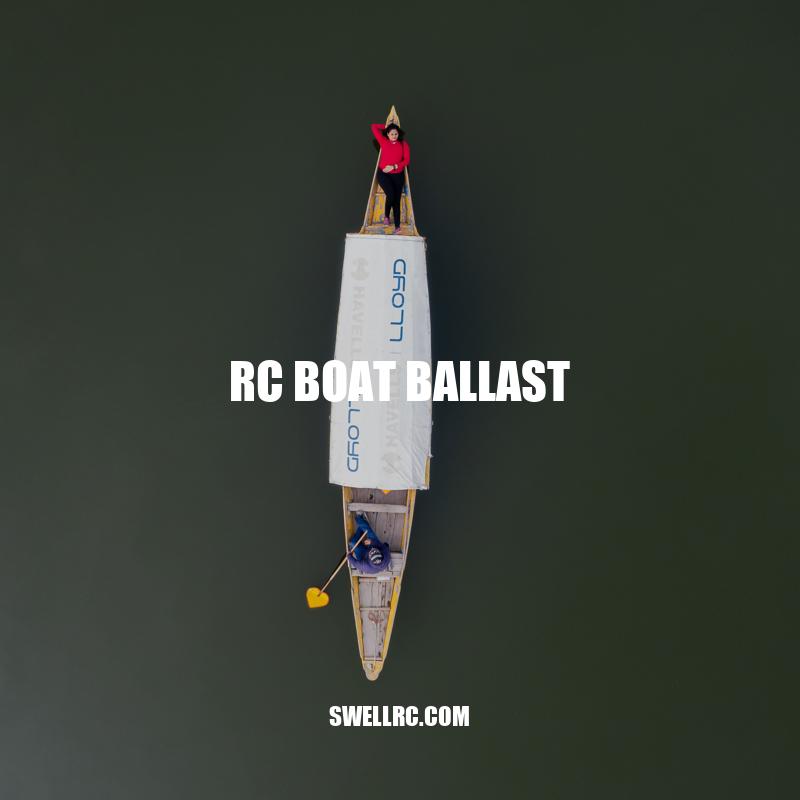Mastering RC Boat Performance with Effective Ballasting
RC boats are becoming more and more popular as a hobby and pastime amongst enthusiasts and beginners alike. With the advancement of remote-controlled technology, RC boats can now be controlled with ease, even from a distance. One of the most crucial aspects of RC boats is their weight distribution and balance. This is where the concept of ballasting comes in. RC boat ballasting is a process of adding weight to the bottom of the boat to stabilize it and improve its performance on water. Ballasting is essential for efficient boat operation, especially when it comes to sailboats or larger, high-performance boats that require proper weight management for optimal speed and maneuverability. An RC boat with poor weight management can easily capsize, turn over, or lose control in choppy water. Therefore, it is vital to ensure that an RC boat is thoroughly ballasted to prevent any safety concerns and improve overall performance. In this article, we will discuss RC boat ballasting in detail, including types of ballast, optimal ballasting, and techniques for better control.
Types of RC boat ballast and their properties
There are two main types of RC boat ballast, each with its unique properties.
- Fixed Ballast: As the name suggests, fixed ballast refers to adding weight to the bottom of the boat to improve its stability. This is typically done by adding lead weights or sandbags. Fixed ballast is an ideal option for smaller or leisure boats that need a bit more weight to stay grounded on the water.
- Adjustable Ballast: Adjustable ballasting systems are more advanced options and offer more flexibility when it comes to weight distribution. These sophisticated systems allow the user to add or take away weight as per their requirements and the water conditions. Adjustable ballasting systems are an ideal option for high-performance boats used for racing, sailing, or other competitions that require top-level performance.
There are a number of products available on the market that can be used for ballasting RC boats. Some popular options include lead weights, sandbags, specially designed ballast bags, and other materials that can be added to the boat as per the user’s requirements. Before adding ballast to your RC boat, it is essential to determine the optimal weight distribution through trial runs.
What do boats use for ballast?
Boats use different materials for ballast such as water, rocks, sand, lead, and concrete. The type of ballast used depends on the size and type of boat. Water is the most common ballast used for small boats, whereas larger boats use lead, concrete, or steel. Boats with shallow drafts typically use sand or rocks for ballast. To choose the appropriate ballast for your boat, it’s important to consult with a marine engineer or boat manufacturer for expert advice. For more information about boating, visit boatus.com or westmarine.com.
Factors that affect the optimal ballast for an RC boat
Several factors play a crucial role in determining the optimal ballast for an RC boat. These factors include:
- Boat Size: The size and shape of the boat significantly impact the boat’s stability and performance on the water. The larger the boat, the more ballast it needs to stay stable.
- Water Conditions: The water conditions, such as waves, wind, and current, can significantly impact the boat’s stability. In rough waters, a heavier ballast may be appropriate to keep the boat steady.
- Speed: The boat’s speed is another factor to consider when determining the optimal ballast. When the boat is going faster, it is essential to ensure that the weight distribution allows for easy maneuverability and control.
- Desired Performance: The desired performance of the boat is another crucial factor. For example, if the boat’s user is looking for maximum speed or agility, a lighter ballasting system may be appropriate. On the other hand, for users looking for stability and control, a heavy ballasting system is ideal.
Below is a table summarising the factors that impact the optimal ballast for an RC boat:
| Factors | Influence on Ballast Requirements |
|---|---|
| Boat Size | As the size of the boat increases, the required ballast weight increases to improve its stability. |
| Water Conditions | Ballast requirements depend on the water’s condition, such as waves, wind, and current, to maintain the boat’s stability. |
| Speed | When the boat is moving faster, maintaining the weight distribution is crucial to ensure maneuverability and control. |
| Desired Performance | The boat user’s desired performance plays a crucial role in determining the ballast requirements. Boat users looking for stability and control require heavier ballasting, while those focused on speed may choose lighter ballasting. |
If you want to get more technical information about RC boats‘ ballasting, you can check out this article about the Role of Ballasting in RC Boats.
Why do boats have ballast?
Boats have ballast to provide stability and balance. The weight of ballast helps prevent the boat from tipping over in rough waters or strong winds by lowering the center of gravity. Ballast can be in the form of water, sand, lead or other heavy materials. Sailboats tend to have a keel that serves as a ballast. Adding or removing ballast can affect the performance of the boat in different ways.
If you want to learn more, head over to websites like Boating Magazine, Sailing World or Yachting World. You can also check out marine supply stores like West Marine or Defender for different types of ballast products.
Adding ballast to an RC boat is a straightforward process, but it requires careful consideration. Below are some steps to follow when adding ballast to an RC boat:
- Determine Optimal Ballast: First, determine the optimal weight and distribution of the ballast. This can be done by conducting trial runs with different weight loads to find the ideal setup for the boat.
- Add Ballast: Once you have identified the optimal weight, it is time to add the ballast. You can use lead weights, sandbags, or specially designed ballast bags.
- Distribute Ballast Evenly: It is crucial to distribute the ballast evenly throughout the boat to prevent uneven weight distribution. This can lead to a loss of control and a potentially dangerous situation on the water.
- Conduct Test Runs: After adding ballast to the boat, conduct test runs to ensure that the boat is still maneuverable, and the weight distribution is optimal.
Keep in mind that adding too much weight to an RC boat can result in slower speeds, lower battery life, and overall decreased performance. It is essential to find the right balance between weight and performance.
There are several RC boat ballasting products available in the market that users can consider. For example, the Traxxas Ballast Weight Set is designed to fit Traxxas boats’ hulls and provide the ideal weight distribution for the best performance. Some websites, such as Horizon Hobby, offer a variety of ballasting products for RC boats.
What does ballast do for a boat?
Ballast is an essential component of a boat’s design. It is weight that is added to the bottom of the boat to improve its stability and control.
Here are some functions of ballast in a boat:
- Reduces the center of gravity and provides stability by countering the top-heavy weight of the boat
- Improves manoeuvrability and reduces rolling and pitching
- Helps to maintain the boat’s trim by distributing the weight evenly
- Provides greater safety by helping to prevent capsizing in rough seas
Different types of boats use different types of ballast, depending on the size, shape, and intended use of the vessel. Some common types of ballast include concrete, lead, water, and sand.
For more information about ballast and boating, you can visit websites such as boatus.com or westmarine.com. These websites offer a variety of boating supplies and accessories, including ballast options.
Conclusion
By adding ballast to your RC boat, you can significantly improve its performance and stability. While there are many factors involved in finding the optimal ballasting for your boat, a bit of experimentation and patience will pay off in the end. Remember to consider key elements such as the boat’s size and shape, water conditions, speed, and desired performance.
It is also crucial to distribute the ballast evenly throughout the boat to ensure proper weight distribution and balance. Adding too much weight can negatively impact the boat’s speed, battery life, and overall performance.
If you are new to RC boating, it’s essential to research and learn about various ballasting options and techniques to ensure a smooth experience. Additionally, check out online forums and resources to connect with other RC boat enthusiasts and gain valuable insights.
In conclusion, RC boat ballasting is a valuable skill to have for any RC boat enthusiast. With the right approach and understanding, you can achieve optimal weight distribution and enjoy a fun and exhilarating experience on the water.



